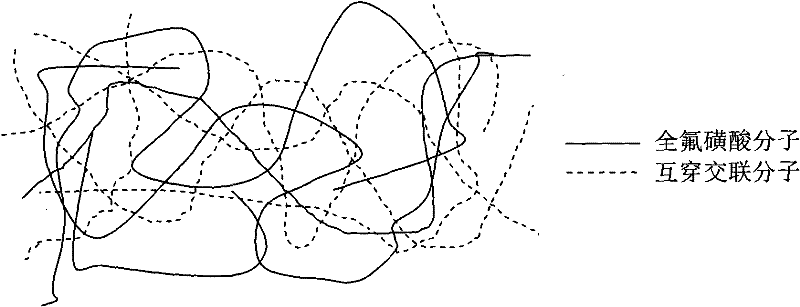Ion exchange membrane with interpenetrating network structure and preparation method thereof
An interpenetrating network structure and ion-exchange membrane technology, applied in the field of polymer functional membrane materials, can solve the problems of difficult control of membrane material composite process, difficulty in large-scale batch production, and environmental pollution of sulfonating agents, so as to reduce membrane protons. Excellent exchange resistance, strong electrochemical corrosion resistance, and simple film production method
- Summary
- Abstract
- Description
- Claims
- Application Information
AI Technical Summary
Problems solved by technology
Method used
Image
Examples
Embodiment 1
[0036] With 120g dry sulfonic acid resin (the number average molecular weight is 75,000, the exchange capacity is 0.95mmol / g, Na + type) was dissolved in 880g N, N-dimethylformamide (DMF), to obtain sulfonic acid solution (casting solution), add sodium vinylbenzene sulfonate monomer 110g, initiator azobisisobutyronitrile 0.5g , and cross-linking agent divinylbenzene (DVB) 50g, after dissolving and stirring evenly, drool on a smooth and horizontal glass surface, evaporate the solvent at 70°C for 10h to form a film, and peel off the glass to obtain an ion exchange membrane. Gas fluorination to obtain an ion-exchange membrane with an interpenetrating network structure with a film thickness of 50 microns.
Embodiment 2
[0038] With 45g dry sulfonic acid resin (number-average molecular weight is 300,000, exchange capacity is 0.8mmol / g, H + type) was dissolved in 880g dimethyl sulfoxide (DMSO) to obtain a sulfonic acid solution (casting solution), adding 100 g of sodium propylene sulfonate monomer, 0.5 g of initiator azobisisobutyronitrile, and crosslinking agent two Dissolve and stir 30g of ethylene glycol methacrylate (EGDMA) evenly, drool on the surface of a smooth and horizontal Hastelloy plate, heat up to 150°C to evaporate the solvent for 1 hour to form a film, and peel off the glass to obtain an ion exchange membrane. Fluorination with fluorine gas to obtain an ion-exchange membrane with an interpenetrating network structure with a film thickness of 30 microns.
Embodiment 3
[0040] With 420g dry sulfonic acid resin (the number average molecular weight is 120,000, the exchange capacity is 1.05mmol / g, Na + Type) is dissolved in 880g N, in the N-dimethylacetamide (DMAc), obtains sulfonic acid solution (casting solution), adds sodium vinylbenzene sulfonate monomer 300g, initiator benzoyl peroxide (BPO) 3g, and cross-linking agent divinylbenzene (DVB) 50g, after dissolving and stirring evenly, drool on a smooth and horizontal glass surface, evaporate the solvent at 100°C for 2h to form a film, and peel off the glass to obtain an ion exchange membrane. The fluorine gas is fluorinated to obtain an ion-exchange membrane with an interpenetrating network structure with a film thickness of 150 microns.
PUM
| Property | Measurement | Unit |
|---|---|---|
| cation exchange capacity (mol) | aaaaa | aaaaa |
| thickness | aaaaa | aaaaa |
| thickness | aaaaa | aaaaa |
Abstract
Description
Claims
Application Information
 Login to View More
Login to View More - R&D
- Intellectual Property
- Life Sciences
- Materials
- Tech Scout
- Unparalleled Data Quality
- Higher Quality Content
- 60% Fewer Hallucinations
Browse by: Latest US Patents, China's latest patents, Technical Efficacy Thesaurus, Application Domain, Technology Topic, Popular Technical Reports.
© 2025 PatSnap. All rights reserved.Legal|Privacy policy|Modern Slavery Act Transparency Statement|Sitemap|About US| Contact US: help@patsnap.com



